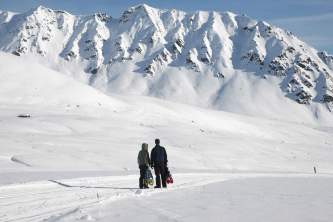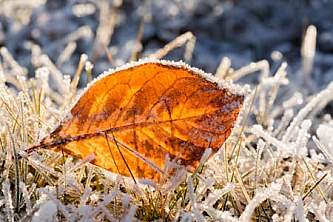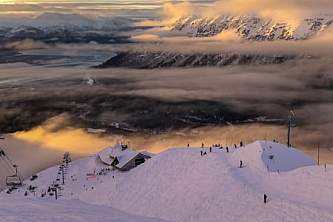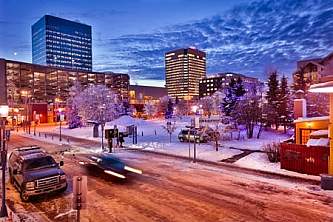Alaska Winter Vacation Tips
Winter in Alaska is a special time full of festivals, performances, and endless outdoor opportunity. As soon as the first snowflakes fall, Alaskans start chomping at the bit to get outside and play! Not everything is open, however, so if you're thinking about traveling to Alaska over the winter months, here's what to keep in mind.
When Should I Visit Alaska During the Winter?
The timing of your trip really depends on what you'd like to do. Here are a couple highlights you might plan your trip around:
- The northern lights. To see the famous aurora borealis, plan your trip for late August through early April.
- Winter festivals. In the last part of February, stretching into March, is when Alaskans celebrate winter during the 10-day Fur Rondy festival. It features dog sled races and numerous community activities, including Outhouse Races, the Running of the Reindeer, and team Snowball Fights. Celebrations continue through the start of the 1,049-mile Iditarod Sled Dog Race in early March.
- Snow & Winter Sports. The first snow of the season in Anchorage is often around the middle to end of October, but generally no significant snow accumulates until November. This happens several weeks earlier for points north like Denali and Fairbanks. Ski resorts generally open late late November and stay open through March, sometimes into April and May depending on the snowfall for the season.
What Can I Do?
Winter brings festivals, ski races, dog sledding tours, northern lights viewing, Nordic skiing, downhill skiing, winter biking, snow shoeing, snowmobiling, gorgeous scenery, ice skating, bonfires, ice fishing, dining, and shopping (whew!). You can take advantage of the longer nights to ski by moonlight, enjoy a bonfire on the beach, or watch for the mysterious auroras. Visit our winter activities page for our full list of recommendations.
What About the Cold?
Temperatures in Southcentral Alaska are no more extreme than other wintry states; the average is 20 degrees. But if you want to see the northern lights, it's best to visit Fairbanks; up there you'll want to pack extra layers, as it can get down to minus-20 degrees.
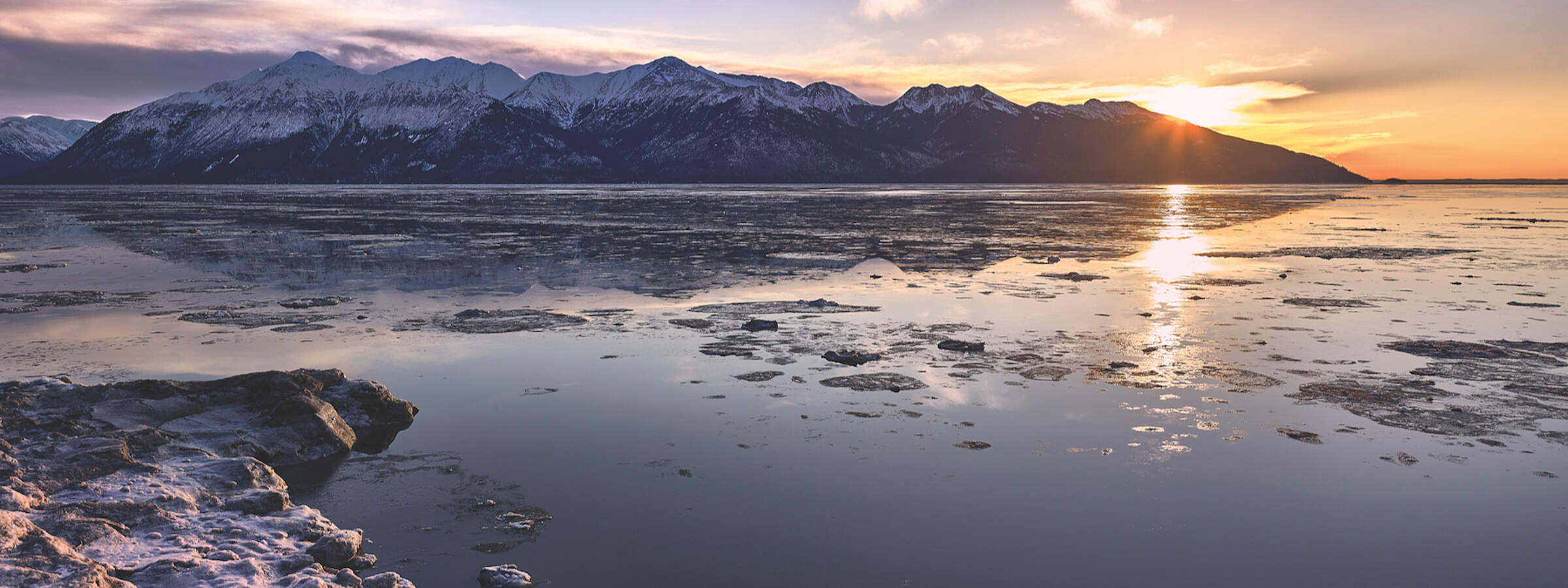
The sun barely peeks over the Kenai Mountains across Turnagain Arm near Anchorage.
Isn't It Dark?
We get 6-12 hours of daily light in the winter, depending on where you are, but the sun setting doesn’t mean your day is done! Dine at one of more than 600 restaurants, visit a museum, or take in a music or theater performance. If you still want to be outdoors, you can discover exquisitely lit ice carvings in Anchorage and Fairbanks; meanwhile, many of the main ski trails, hockey rinks, and sledding areas are lit. Find out when the sun will rise and set during your Alaska trip using the Alaska.org Sunrise/Sunset Calculator.
Is It Expensive to Visit in Winter?
Actually, you can book lodging for more than 50% off of summer rates, and you'll find great deals on many tours. Even better, activities like Nordic skiing and ice skating are free if you already have equipment.
What About Winter Transportation?
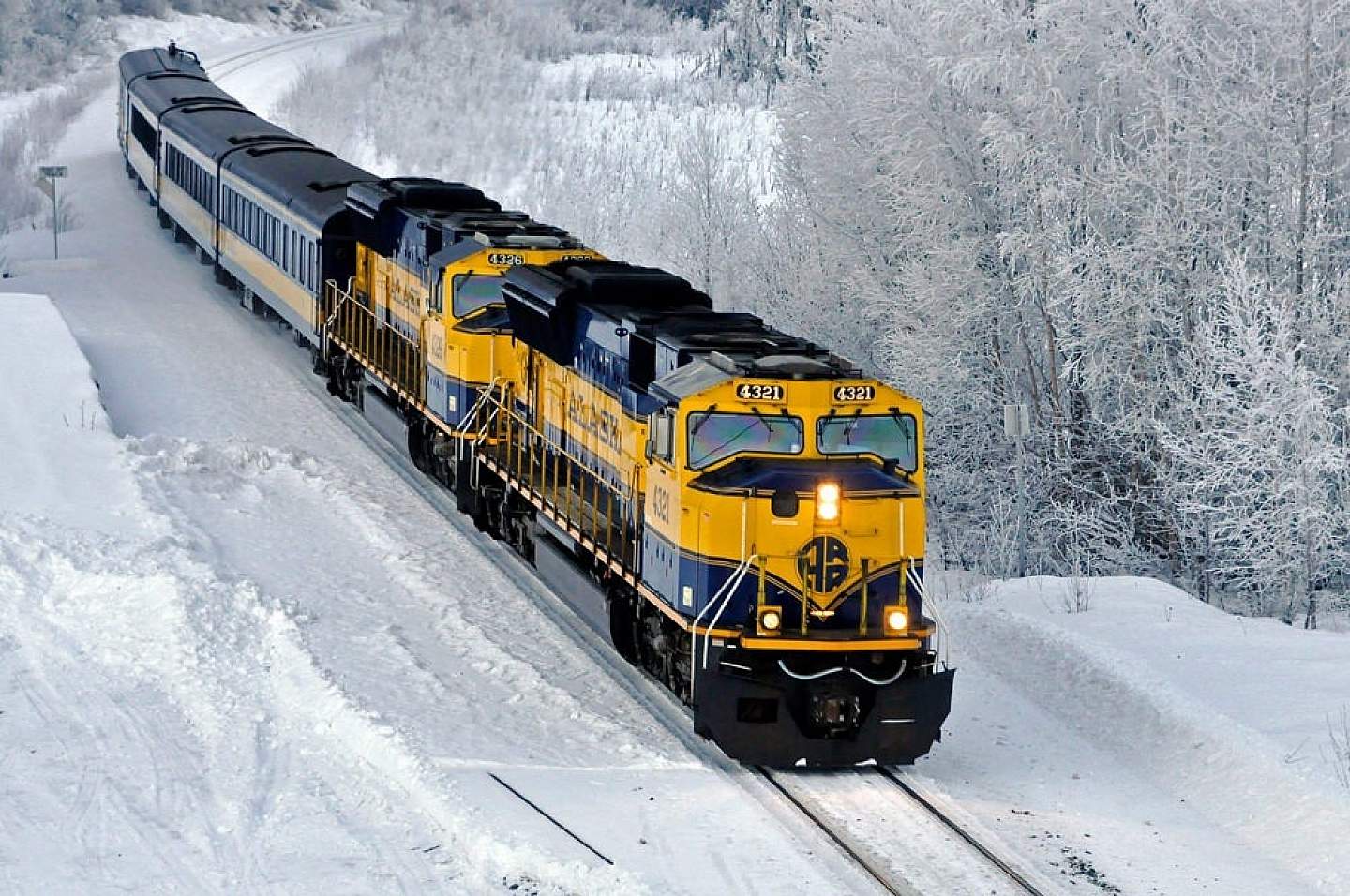
Ride the scenic Alaska Railroad in winter.
There are definitely fewer public or guided transportation options during winter in Alaska, but it’s still relatively easy to get around. Here are some winter-specific suggestions.
- Rent a car. If you have experience driving during winter conditions—especially on roads with compacted snow or ice—don’t hesitate to rent a front-wheel or all-wheel drive vehicle. (Some vendors offer studded or special winter tires for an additional fee.)
- Take a plane. Alaska Airlines maintains daily service to communities throughout the state all winter. Round-trip between Anchorage and Fairbanks is often $150 or less, and takes an hour or less. For the adventurous, investigate travel to remote sites with a bush pilot or charter operator on a ski-equipped aircraft.
- Ride a train. The Alaska Railroad maintains an adventure-oriented winter service that connects Anchorage, Wasilla, Talkeetna, Hurricane, Healy, Nenana, and Fairbanks. The railroad also offers winter travel packages with accommodations and activities like pie-making, sightseeing, and aurora watching.
- Take a bus. Winter offers far fewer options, but a few bus operations maintain winter schedules from Anchorage to Seward and Homer, and Anchorage to Fairbanks.
- Board a ferry. The Alaska Marine Highway System scales back during winter. You can still find connections among Southeast Alaska communities or within Prince William Sound—or make the Homer-Kodiak run. Scope out the interactive sailing calculator as a start.
- Take a shuttle or taxi. Most medium and large communities have taxis or shuttles. In Anchorage and Fairbanks, winter has the same full service you’d find in summer.
Is It Really Safe to Drive?
Yes! Alaska’s highways and main roads are usually in decent driving shape (except during some dramatic weather event, of course). State and local crews generally get roads cleared and sanded quickly after bad weather. This includes the southcentral core area—Anchorage, Matanuska-Susitna Borough, and Kenai Peninsula. If you're traveling north to Fairbanks or the Copper River Basin road conditions are often good and traffic is light. To be sure, mountain and rural roads can be more challenging.
Check out our winter clothing tips before you embark on a road trip into more remote areas. You can also reserve a rental car with studded winter tire which provide extra grip on slick roads. Get real-time condition reports from Alaska’s Road Weather System and the state’s 511 traveler alert site.
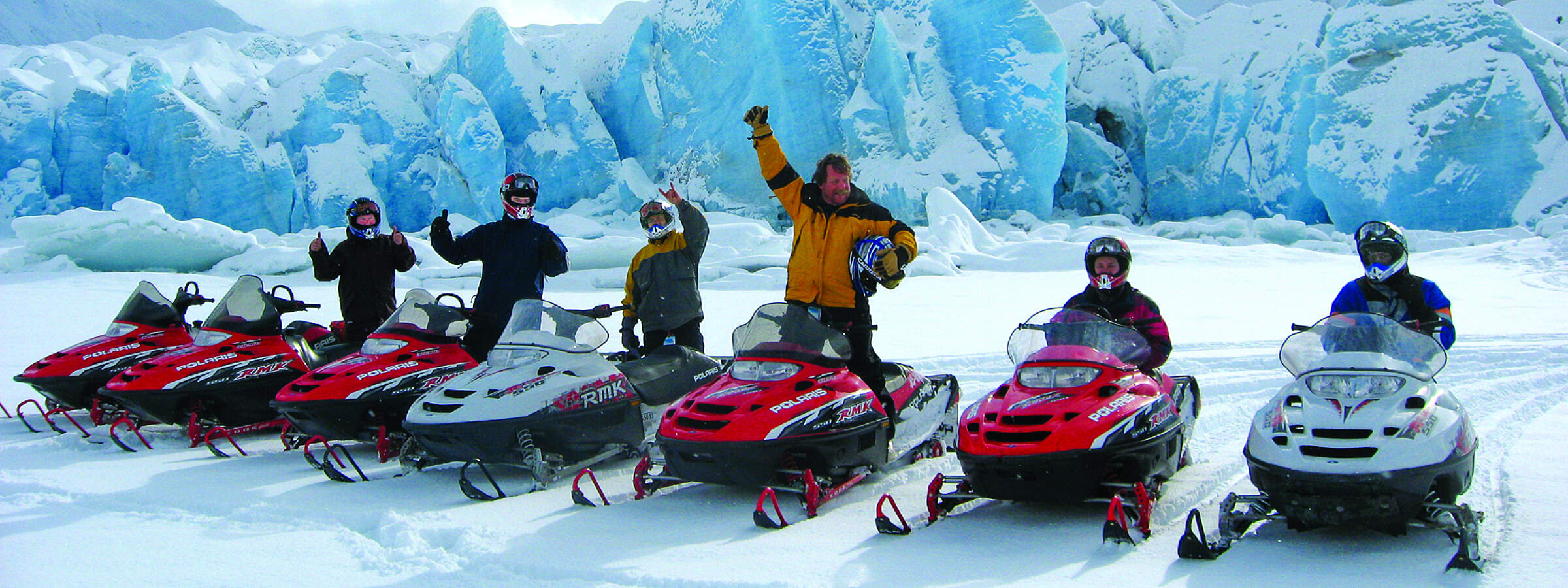
Snowmobilers on a tour with Glacier City Snowmobile Tours take a pause in front of Spencer Glaicer for a photo op
Can I See Glaciers?
Yes. But after snow covers them in late fall, sometimes they become more difficult to discern.
Matanuska Glacier is a popular glacier to visit year-round. You can join a trek on the ice with Salmon Berry Tours or Wild Alaska Journeys.
Another popular winter glacier is Spencer Glacier. You can get there on an exciting snowmobile ride with Glacier City Snowmobile Tours or Alaska Wild Guides.
Several glaciers actually become easier to approach once their lakes freeze solid. Turnagain Arm’s Portage Glacier—approachable only by tour boat in summer—morphs into a popular destination for hikers, skaters, snow-bikers, and skiers after the ice sets up. Hundreds of people converge on sunny weekends in March and April. Mendenhall Glacier near Juneau features the same dynamic.
Glaciers that spill into the sea may be even more spectacular during winter, especially on a sunny day with snow down to the shore. A few tour operations sometimes maintain limited winter schedules, but you’ll have to call. Lazy Otter Charters in Whittier has a Blackstone Bay tour, for instance. Some Seward operators will run charters into Kenai Fjords National Park.
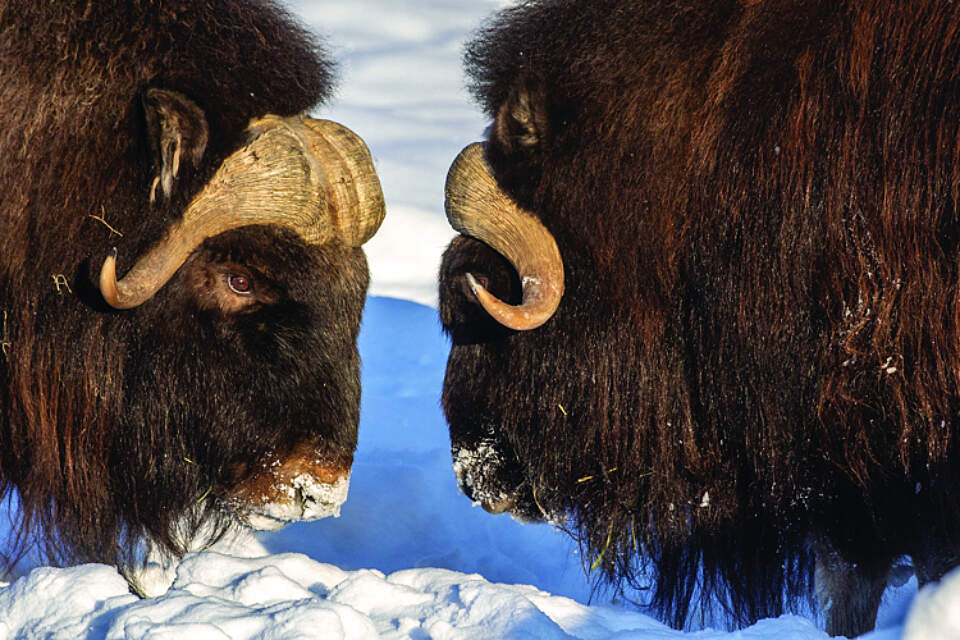
Musk ox at the Alaska Wildlife Conservation Center
Will I See Wildlife?
You probably won’t see hibernating bears or glimpse Alaska’s tremendous migratory bird life. But many moose roam Alaska’s winter landscape—including in city neighborhoods and parks, and in any brushy, low-snow area like the Palmer Hay Flats State Game Refuge. Ravens are common, too—especially inside cities, where they scavenge for morsels. Bald eagles remain in coastal areas, while flocks of black-capped chickadees and redpolls flutter through the forest. Also look for the tracks of snowshoe hares, lynx, foxes, coyotes, weasels and (sometimes) wolves in the fresh snow. For more intimate views of Alaskan animals in their winter splendor, visit the Alaska Zoo in Anchorage and the Alaska Wildlife Conservation Center in Portage.
Can I Visit National Parks?
Yes! But expect more limited access and reduced visitor services, depending on the park. Always check individual park websites for details and conditions
- Denali National Park. Iconic Denali has an active winter scene, with the Murie Science and Learning Center open every day and the famous Park Road plowed through Mile 3. While most tours and activities will be closed, self-sufficient visitors attuned to Alaska’s dark, snowy season enjoy cross-country skiing, snow-shoeing, dog-sledding, and winter biking, as well as gazing at stars and northern lights.
- Wrangell-St. Elias National Park. The vast and more remote Wrangell-St. Elias remains open to self-sufficient visitors pursuing winter adventures, but its facilities and visitor centers close for the season.
- Kenai Fjords National Park. The road to Exit Glacier in Kenai Fjords generally closes to vehicle traffic about 8 miles out once snow falls, but it's common to visit the glacier area using cross-country skis, winter bikes, snowshoes, and snowmachines (once it opens to snowmobiling). To visit the park’s rugged outer coast, check out Seward charter boat operators for a custom tour.
What Are the Winter Holidays Like?
Alaska’s holiday season is a busy and raucous time, marked by festivals, bazaars, and—once the snowpack builds—the explosive advent of winter sports season. It’s a great time to visit. Cities like Anchorage and Fairbanks are full of activities and shopping. Alaskans fully embrace the dark solstice with family gatherings and parties. Anchorage lights up with colored lights, including a giant star on the mountain east of town. The two-week year-end period can feel like one continuous holiday, with public events almost every day.
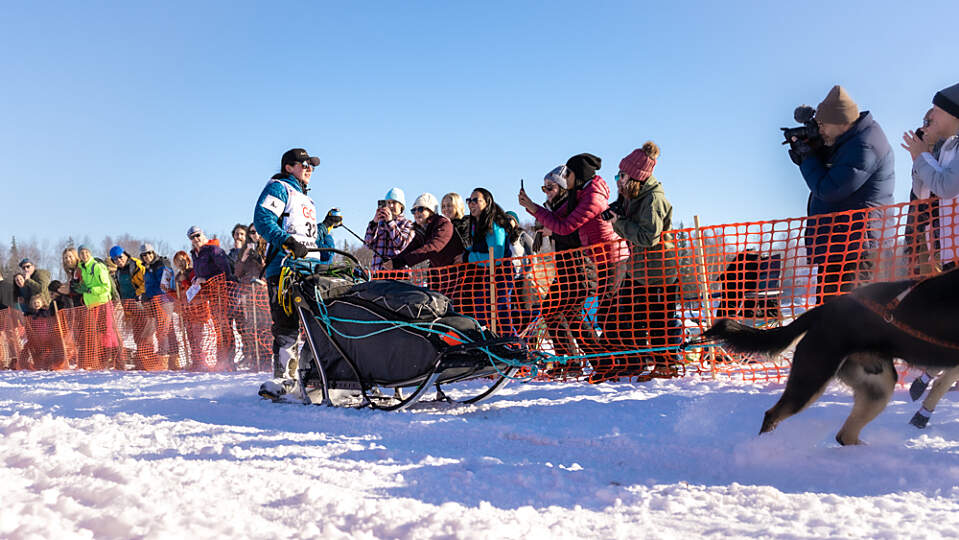
Musher glides past the crowd gathered in Willow to watch the official start of the Iditarod
What Are the Big Winter Events?
Alaska has dozens of festivals and winter sports contests, including many in Anchorage. Here are the marquee bashes that draw thousands of spectators and participants every year.
- The Yukon Quest International Sled Dog Race. Billed as the world’s toughest sled dog race, this 1,000-mile epic mush between Fairbanks and Whitehorse traverses the snowbound terrain of the classic pioneer Gold Rush in early February.
- The Open North American Sled Dog Championships. This dogsledding event features classic sprint mushing performed by people who live for the sport during the first week of March.
- The Anchorage Fur Rendezvous. This 10-day celebration of winter in late February and early March features scores of activities like ice-sculpting competitions, fireworks, live music, and the world championship sprint sled dog race that begins and ends downtown.
- The Iditarod Trail Sled Dog Race. This world-famous race crosses 1,000 miles from Anchorage to Nome, with the ceremonial start on the first Saturday in March in downtown Anchorage. Dog teams launch down city streets and travel along park trails into the forest as tailgate-style barbecues erupt all over town.
- The Tour of Anchorage ski marathon. Hundreds of people ski across Anchorage in four races that range from 25K to 50K, in both classic and skate styles. It's usually held the first Sunday in March. Even if you don’t come to race, you'll find the best and most extensive grooming of the year.
The Top Winter Destinations in Alaska
- Alyeska Resort and Girdwood. Alaska’s biggest downhill ski area features some of the longest and most challenging ski runs in North America. With multiple lifts and an Alps-style aerial tram rising from near sea level into alpine terrain, the resort draws visitors from all over the world. Amenities include the full-service Hotel Alyeska, excellent restaurants, a salt-water swimming pool, and a way-cool roundhouse museum perched on a mountain ridge. The surrounding community of Girdwood boasts many restaurants and shops that are popular with both Anchorage locals and travelers. The groomed cross-country ski trails include an expert 5K loop and casual routes through meadows.
- Anchorage. Alaska’s largest city is probably Alaska’s biggest winter destination. It’s often gorgeous in winter—and you’ll never run out of things to do. Once snow blankets the Chugach Mountains and the city sparkles with lights, the setting transforms into a winter wonderland, with just about every kind of snow-and-ice recreation minutes from great dining and lodging. Ski across town on one of the country’s most extensive groomed trail systems (much of it lighted). Skate hot-mopped and plowed rinks on lakes. Watch dog mushing or go snow biking. Indoors, there are museums, scores of restaurants and music venues, regular performances, and college sports. As Alaska’s main transportation hub, Anchorage offers visitors a launch pad for adventures into just about every other corner of the state.
- Fairbanks. To experience a full-bore Far North winter (frigid temperatures, dry powder snow, dancing aurora) plus a city with full-service lodging, fine restaurants, a university scene, and the world-class Museum of the North, visit Fairbanks from November to March. Outdoor recreation possibilities include dog mushing, snow-shoeing, cross-country and downhill skiing, ice fishing, and snowmobile tours. Nestled at the confluence of Alaska’s northern highway system, Fairbanks is the launch point for adventures into remote villages and the state’s Arctic Slope. For a very doable road trip from Fairbanks, visit Chena Hot Springs Resort, whert The aurora viewing is among the world's most spectacular.
- Visit the seashore. Both Homer and Seward nestle along bodies of water that don't freeze in winter, and there’s nothing quite like a stroll down an Alaskan beach pounded by winter surf. It's an intriguing, wintry, and sometimes exhilarating experience of the North Pacific Ocean during its most inhospitable season. On calm days, Resurrection Bay by Seward and Kachemak Bay by Homer will offer glimpses of marine mammals, wintering sea birds, and hard-core fishing and shipping traffic. While tour and ocean charter options are limited, you'll find full-service lodging and local restaurants near the shore, surrounded by laid-back communities that become as quaint and welcoming as a scene on a holiday card.
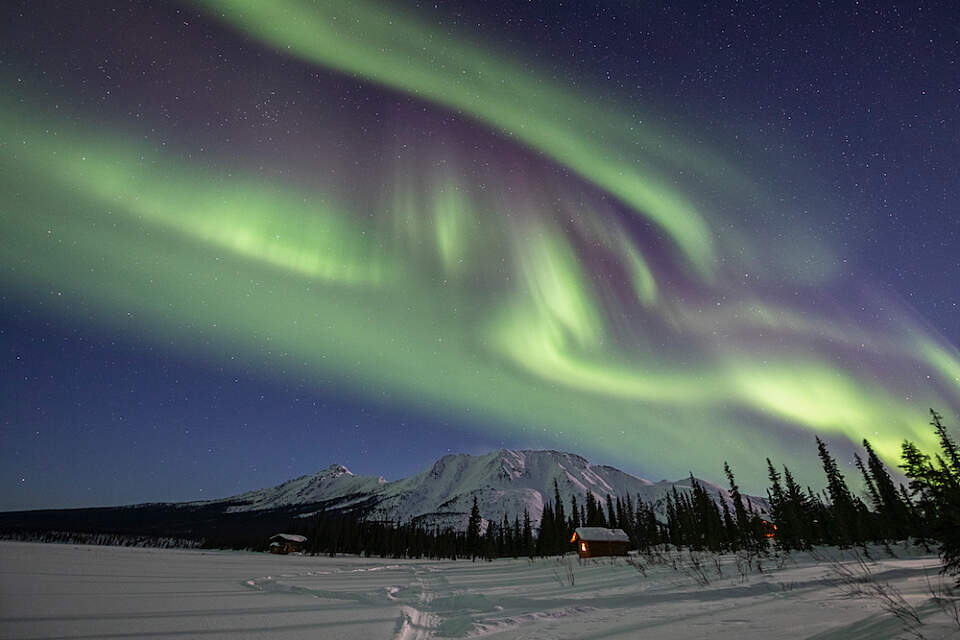
Iniakuk Lake Wilderness Lodge
What Are Some Great High-End Accommodations?
For a start, check out these options:
- Hotel Alyeska sits at the base of state’s biggest ski resort in Girdwood.
- Hotel Captain Cook, in downtown Anchorage, offers an old-fashioned, big-city hotel experience.
- Iniakuk Wilderness Lodge is a luxurious hand-built lodge, 60 miles above the Arctic Circle and 200 miles north of Fairbanks in Gates of the Arctic National Park. Custom packages run from 3 to 5 nights and include activities like aurora viewing and dog mushing.
- Susitna Adventure Lodge, situated along the Denali Highway, is accessible by ski plane, a 60-mile snowmachine ride, or a multi-day dog sled trek which will only add to the adventure! Stays are all-inclusive.
What About Rustic Cabins?
From old-style roadhouses featuring rentals within walking distance of a restaurant to the state’s extensive network of do-it-yourself public use cabins, you'll find scores of winter accommodations across Alaska. They range from semi-luxurious venues with services to wilderness outposts where you must chop wood, melt water, and be totally self-sufficient.
- Salted Roots in Seward is your cozy cabin option on the coast. This brand-new space features four craftsman cabins. 2 glass-front Aframes that can accommodate 6, and 2 cozy cottages with a master bedroom view overlooking Resurrection Bay. The barrel sauna on site is the perfect place to warm up on a winter day.
- Borealis Basecamp puts the northern lights right in your room, with domed windows that reveal the night sky.
- If you're prepared to go off-grid and deal with the winter travel logistics required to reach a public use cabin, check out our interactive guide. Just book well in advance. The most popular cabins and lodges fill up months ahead of time.
Click here for a full list of the best winter accommodations in Alaska.

